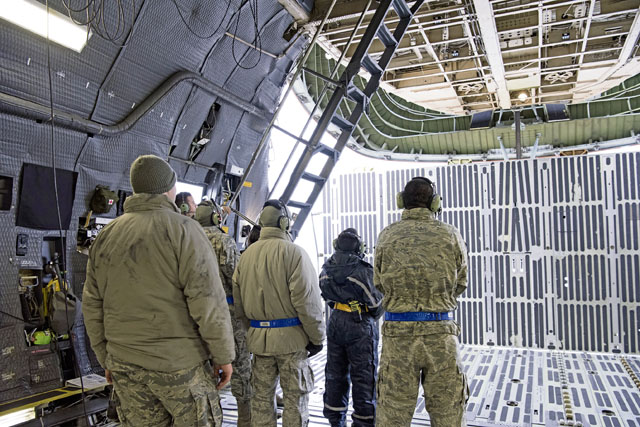
More than 30 U.S. Air Force Reserve aircraft maintainers assigned to the 512th Airlift Wing along with a 436th Airlift Wing C-5M Super Galaxy aircraft and crew traveled to Ramstein AB Nov. 23, to assist the 521st Air Mobility Operations Wing with vital hands-on, airframe-specific training.
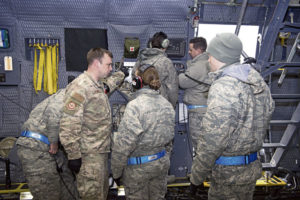
During a first-of-its-kind, two-week C-5 training session, which uniquely featured a dedicated C-5M Super Galaxy trainer aircraft, more than 140 aircraft maintainers and aerial port Airmen assigned to the 521st AMOW completed more than 980 proficiency tasks, a feat that may have taken more than a year under current practices, said Col. Brad Spears, 521st AMOW commander.
The 521st AMOW’s mission, to “expedite global reach to professionally answer our Nation’s call,” relies heavily on skilled aircraft maintainers who ensure transient aircraft get the maintenance they need en route.
“The 521st AMOW is really here in Europe and the U.S. Central Command areas of responsibility to provide stepping stones and velocity to the mobility system,” Spears said. “We do that through maintenance, aerial port, and command and control … to make sure the strategic airlift assets moving eastbound to destinations in the U.S. Africa Command, CENTCOM or the U.S. European Command AORs and westbound back to the continental U.S. are taken care of.”
To date, en route training in the Eastern Enterprise, a nickname for the 521st AMOW’s area of operations, has been primarily limited to three training locations, Ramstein AB, Naval Station Rota, Spain, and Incirlik Air Base, Turkey.
With more than 2,100 personnel spread out across nearly 20 geographically separated units throughout Europe and the Middle East, ensuring uniform training for all 521st AMOW maintenance personnel can be challenging at best, Spears said. This is especially true for maintainers working on the C-5. The massive aircraft has a wingspan of nearly 223 feet, a cargo compartment almost 145 feet long, and can transport up to 280,000 pounds.
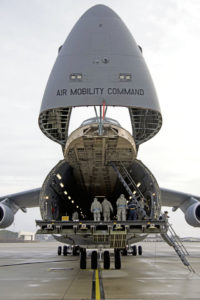
The U.S. Air Force’s largest plane, the C-5, features several unique characteristics, including a nose cargo door and a kneeling nose gear, which allow for drive-on capability. While the Air Force began modernizing the aircraft in 1998, the fleet is rapidly approaching 50 years of service.
The age and unique characteristics of the airframe require routine, specialized maintenance. If something breaks when the aircraft is not at its home station, the Air Force relies on skilled en route maintainers to quickly identify and fix the problem.
“We work on the C-5 aircraft every single day here in the 521st AMOW, but we’re normally just moving them along in the system,” Spears said. “We provide them the servicing they need to continue with the mission, and we try to do that in as rapid fashion as possible.”
The Air Force currently owns 52 Super Galaxy aircraft, which are only assigned to four units worldwide. Getting hands-on maintenance time with the aircraft is difficult for many AMOW maintainers because flight schedules and aircraft maintenance needs constantly change in a dynamic global airlift environment.
Lt. Col. Robert Ryder, 521st AMOW deputy commander for operations and the person who oversees the wing’s training programs, said they could request a training aircraft through Air Mobility Command A4 Logistics, Engineering and Force Protection Directorate and the 618th Air Operations Center, formerly the Tanker Airlift Control Center, both located at Scott Air Force Base, Illinois. These organizations work together to coordinate rapid global mobility.
This method for requesting trainer aircraft seldom met all of the en route maintenance training requirements, especially for the Airmen assigned to the more remote GSUs, Ryder said.
“The mission always comes first,” Ryder said. “A trainer aircraft may be planned to stay here for 48 hours; however, sometimes the aircraft arrives late, departs early or gets re-tasked somewhere along the way. And for those reasons, we don’t always get the full benefit of the trainer.”
Ryder said at most, 10 Airmen are able to train on the aircraft in ideal circumstances, and when the timeframe and condition of the aircraft cannot be confirmed, the unit cannot arrange for the GSU maintainers to participate.
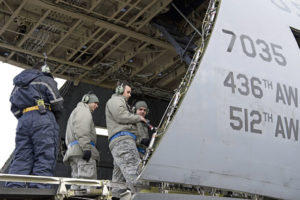
Col. Joel Safranek, 436th Airlift Wing commander, Dover, Delaware, became aware of the need for improved en route training during his previous assignment as the 621st Contingency Response Wing vice commander at Joint Base McGuire-Dix-Lakehurst, New Jersey. When he took command of the 436th AW, he began working with the 436th and 512th maintenance groups to enhance the en route training plan for Ramstein AB.
Ultimately, after about four months of coordination between four organizations — the 436th AW, 512th AW, 521st AMOW and the 618th AOC — a plan emerged.
The 618th AOC generated a C-5 cargo mission from Dover AFB to Ramstein AB and a return flight two weeks later. Because the aircraft was built into the cargo transportation schedule, it was used effectively to fly channel missions on its flights to and from Ramstein, allowing it to contribute to the larger AMC mission as well as support the 521st AMOW’s training requirements.
The 521st AMOW regional training center developed a master training plan for the two weeks they had the aircraft. Based on this plan, GSUs selected maintainers who would benefit most from the identified training and generated temporary duty orders.
The 512th Maintenance Group sent several maintainers to assist with the training and work the flight line, freeing up 521st AMOW maintainers to participate in the training. Since every reservist is required to serve a minimum of two weeks a year, this opportunity allowed the reservists a productive way to fill that requirement.
In fact, the 512th MXG has a decades-long tradition of conducting such en route training during their annual tour requirements. Thanks to the dedicated efforts of the four units, this time their tour coincided with a dedicated trainer aircraft.
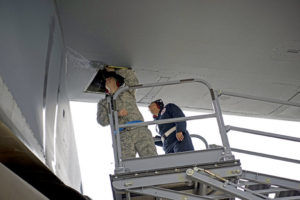
“It appears to be a win-win-win-win scenario,” Safranek said. “The 521st AMOW wins by getting the training they need. Our wing wins by providing a C-5 at no additional cost; and at the same time, the aircraft may come back in better shape than it went out the door. AMC is able to move channel cargo during the positioning and de-positioning legs. And our reserve mission partners are able to gain valuable experience during their annual tour. We all win through a little cooperation.”
This spirit of cooperation is nothing new. The 436th and 512th AWs work together every day to execute global airlift 365 days a year.
“I’m proud of the Liberty Wing Citizen Airmen who volunteered to assist the 521st AMOW Airmen hone their maintenance skills,” said Col. Craig Peters, 512th AW commander. “As a Total Force effort, this unique training opportunity will improve the lethality of our already highly capable en route maintenance system. Developing and leveraging the enhanced mobility partnerships created over this two-week event will further allow us to provide Rapid Global Mobility to the right place at the right time.”
The plan was not overly complicated, and was done through cooperation amongst three wings and the 618th AOC and did not require any direction from higher headquarters.
“I’m convinced that this is a very great model for the AMOW, and I hope it is similarly advantageous for the 436th AW,” Spears said. “The synergistic effect of having the training over a deliberate timeframe is going to pay huge dividends for us. We’re going to find that our Airmen are more ready tomorrow than they are today. We’ll be looking to repeat this as soon as we can.”
If this proves to be an effective model for AMOW C-5 training, Ryder, Safranek and Spears all said they hope the process of having a dedicated ground trainer for a two-week increment could be mirrored by the 60th Air Mobility Wing at Travis AFB and the 515th AMOW at Joint Base Pearl Harbor-Hickam, Hawaii. The commanders said this is something they would like to continue on a quarterly basis.
Ryder said he believes the benefits of this training will be immeasurable.
“A year from now, we will look back on this particular event as probably the singularly most important thing that changed how en route training is conducted,” Ryder said. “My suspicion is that this is going to set the stage for what is to come.”


